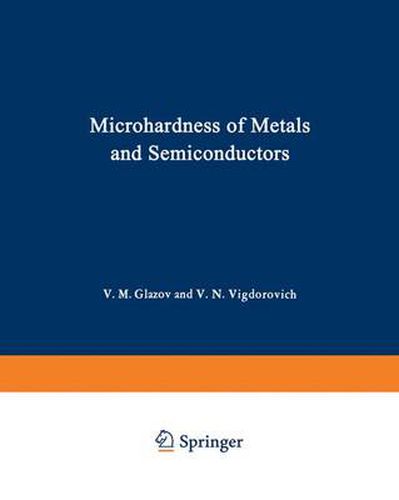Readings Newsletter
Become a Readings Member to make your shopping experience even easier.
Sign in or sign up for free!
You’re not far away from qualifying for FREE standard shipping within Australia
You’ve qualified for FREE standard shipping within Australia
The cart is loading…






This title is printed to order. This book may have been self-published. If so, we cannot guarantee the quality of the content. In the main most books will have gone through the editing process however some may not. We therefore suggest that you be aware of this before ordering this book. If in doubt check either the author or publisher’s details as we are unable to accept any returns unless they are faulty. Please contact us if you have any questions.
In our earlier monograph Mlcrohardness of Metals [1], published in 1962, we attempted to correlate a variety of investigations scattered throughout a number of journals with the gen- eral theme of solving problems of physicochemical analysis and metallography by microhard- ness measurements. The publication of Microhardness of Metals promoted the widespread use of this tech- nique in studying physicochemical phenomena in various materials. In recent years the micro- hardness method has been used most extensively in studying semiconducting materials, and this has necessitated the revision of the monograph with the aim of incorporating new experi- mental data relating to both metals and semiconductors. The greater proportion of the material presented in this book reflects the authors’ own investigations. other investtgations associated with the use of the microhardness method in tOO physicochemical analysis of metallic and semiconducting systems are also taken into account. The authors are extremely indebted to Academician G. G. Urazov for his great interest in this work at its inception and for a number of valuable comments regarding the possibility of using the microhardness technique in physicochemical analysis. Sincere thanks are extended to Academician A. A. Bochvar and Professors A. N. Krestov- nikov, M. M. Khrushchov, M. V. Mal'tsev, M. V. Zakharov, and I. I. Novikov for their interest in these investigations.
$9.00 standard shipping within Australia
FREE standard shipping within Australia for orders over $100.00
Express & International shipping calculated at checkout
This title is printed to order. This book may have been self-published. If so, we cannot guarantee the quality of the content. In the main most books will have gone through the editing process however some may not. We therefore suggest that you be aware of this before ordering this book. If in doubt check either the author or publisher’s details as we are unable to accept any returns unless they are faulty. Please contact us if you have any questions.
In our earlier monograph Mlcrohardness of Metals [1], published in 1962, we attempted to correlate a variety of investigations scattered throughout a number of journals with the gen- eral theme of solving problems of physicochemical analysis and metallography by microhard- ness measurements. The publication of Microhardness of Metals promoted the widespread use of this tech- nique in studying physicochemical phenomena in various materials. In recent years the micro- hardness method has been used most extensively in studying semiconducting materials, and this has necessitated the revision of the monograph with the aim of incorporating new experi- mental data relating to both metals and semiconductors. The greater proportion of the material presented in this book reflects the authors’ own investigations. other investtgations associated with the use of the microhardness method in tOO physicochemical analysis of metallic and semiconducting systems are also taken into account. The authors are extremely indebted to Academician G. G. Urazov for his great interest in this work at its inception and for a number of valuable comments regarding the possibility of using the microhardness technique in physicochemical analysis. Sincere thanks are extended to Academician A. A. Bochvar and Professors A. N. Krestov- nikov, M. M. Khrushchov, M. V. Mal'tsev, M. V. Zakharov, and I. I. Novikov for their interest in these investigations.